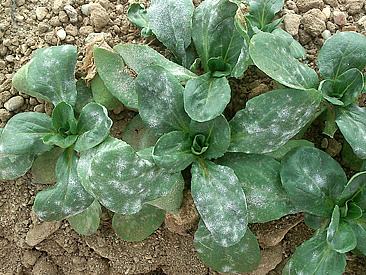The term “powdery mildew” refers to plant diseases caused by fungi of the Erysiphaceae family. This family is notable for its diversity, housing 28 genera and about 1,000 species, highlighting the wide variety of fungi that cause this disease. The vast majority of powdery mildew fungi are obligate parasites, specialized in different plant species. They are characterized by a mycelium that grows on the surface of the host plant, forming a network of hyphae that penetrate the cells of the host’s epidermis through specialized organs known as haustoria. These haustoria are essential for nutrient extraction, supporting the parasitic fungus.
The symptoms of powdery mildew are distinct and easily identifiable, aiding in the rapid detection and control of the disease. Initially, small white or gray, powdery, irregularly shaped spots appear on the leaves, stems, flowers, or fruits of affected plants. Over time, these spots tend to increase in size and join together, forming large patches. The appearance is similar to a thin layer of flour covering the affected organs of the plant. Additionally, the lower and newer leaves are commonly the first to show signs of the disease. With the progression of powdery mildew, plants may suffer from leaf, flower, and fruit drop, fruit cracking, general weakening, and, in severe cases, even death.
The life cycle of powdery mildew is complex and adaptable, with both sexual and asexual phases. This cycle allows the fungus to survive under adverse conditions and spread rapidly under favorable conditions. Powdery mildew is transmitted by wind and vector insects, such as aphids, and can infect a wide range of crops, including grapes, grasses, tomatoes, pumpkins, cucumbers, melons, cashews, beans, strawberries, mangoes, cassava, peanuts, papayas, among others. Additionally, various ornamental plants such as roses, zinnias, lilacs, phlox, hydrangeas, heathers, begonias, cyclamens, azaleas, daisies, chrysanthemums, and cypresses are also affected.
A crucial aspect of powdery mildew is host specificity. Generally, a powdery mildew species attacks only one plant species or at most a few related ones. For example, the powdery mildew that affects tomatoes (Leveillula taurica) is not the same as that which affects daisies. Similarly, the fungus that attacks pumpkins (Podosphaera xanthii) can also affect gourds and melons, which belong to the same family, the Cucurbitaceae. During the winter, powdery mildew can remain dormant in plant organs and organic matter, resuming growth in spring and summer, favored by high temperatures.
To prevent and control powdery mildew, it is essential to eliminate the affected parts of the plant, such as leaves, branches, flowers, and fruits, through composting, burying, or burning them. This action helps destroy the spores and prevent new infection foci. Keeping plants well-nourished and hydrated, without excess, is crucial to preventing the onset of the disease. Powdery mildew often appears under conditions different from those that commonly facilitate the emergence of fungal diseases. Paradoxically, while fungi generally appear when there is an excess of organic matter and high humidity, powdery mildew is frequently present even in dry periods.
Thus, cultural practices, such as balanced fertilization and maintaining a good water regime, play an important role in prevention. In addition, it is important to keep plants in a well-ventilated environment, with adequate spacing and good lighting, avoiding excessive watering and waterlogged conditions. Warm and humid greenhouses are particularly prone to the rapid spread and development of powdery mildew, requiring special care.
A sustainable strategy for dealing with powdery mildew is the selection of cultivars and plant varieties that are resistant to this disease, especially in areas where the problem is recurrent. Organic control methods, such as spraying aqueous solutions containing sulfur, baking soda (1 teaspoon per liter), or raw cow’s milk (5%), have proven effective both in prevention and control of powdery mildew. Diatomaceous earth, rich in silicon, strengthens the cuticle and epidermis of plants, proving efficient in the prevention and control of powdery mildew. These methods are more economical and environmentally friendly compared to commercial fungicides.
In the chemical control of powdery mildew in ornamental plants, fungicides such as myclobutanil, difenoconazole, cyflufenamid, meptyldinocap, azoxystrobin, proquinazid, penconazole, tebuconazole, triticonazole, triadimefon, propiconazole, and fenarimol are frequently used. However, it is essential that these fungicides be applied under the prescription and guidance of an agricultural or forestry engineer, as they are potentially toxic products and can cause significant harm to human health and the environment if not used correctly.


